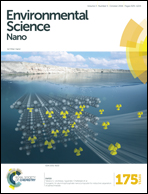Carbonaceous nano-additives augment microwave-enabled thermal remediation of soils containing petroleum hydrocarbons†
Abstract
Remediating soils contaminated with heavy hydrocarbons (C12–C40) from petrochemical exploration activities is a major environmental challenge across the globe. This study evaluated microwave irradiation in the presence of nano- and macro-scale graphitic additives as a rapid remediation technology for removing heavy hydrocarbons from soil. Adding inert materials (i.e., glass wool fibers or washed silica sand) as controls had no effect on total petroleum hydrocarbons (TPH) removal upon microwave irradiation. Carbonaceous nanomaterials (i.e., carbon nanotubes, graphene nanosheets, and carbon nanofibers) because of their favorable dielectric properties showed extraordinary heating performances when mixed with soil and microwave irradiated. As a result, adding these carbonaceous nanomaterials to contaminated soils removed more TPH compared with macro-scale carbonaceous additives. TPH concentrations decreased from 11 000 to between 2000 and 6000 mg TPH kg−1 soil within one minute using carbon nanomaterial additives and a 2.45 GHz, 1000 W conventional microwave oven. In separate experiments, this technology decreased TPH from 2500 to 650 mg TPH kg−1 soil from soils containing recalcitrant, non-biodegradable fractions of TPH. Large scale microwave systems are available and hold promise for remediating soils when used in conjunction with carbon nanomaterials.


 Please wait while we load your content...
Please wait while we load your content...